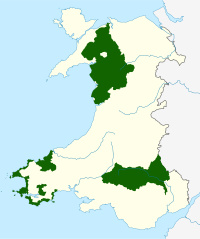
Back المتنزهات الوطنية في ويلز Arabic Parciau cenedlaethol Cymru Welsh ਵੇਲਜ਼ ਦੇ ਰਾਸ਼ਟਰੀ ਪਾਰਕ Punjabi ویلز دے نیشنل پارک PNB Parques Nacionais de Gales Portuguese
- Snowdonia (Eryri)
- Brecon Beacons
(Bannau Brycheiniog) - Pembrokeshire Coast
| UK National Parks |
|---|
| Parentheses denotes the year. An area with ‡ has similar status to a UK National Park. Areas marked † are proposed. |
The national parks of Wales (Welsh: parciau cenedlaethol Cymru) are managed areas of outstanding landscape in Wales, United Kingdom where some forms of development are restricted to preserve the landscape and natural environment. Together, they cover 20% of the land surface of Wales and have a resident population of over 80,000 people. Each National Park Authority is a free-standing body within the local government framework.
At present, Wales has three national parks: Snowdonia (Eryri), created in 1951, Pembrokeshire Coast, created in 1952, and the Brecon Beacons (Bannau Brycheiniog), created in 1957, as well as five areas of outstanding natural beauty (AONB), which form some of the protected areas of Wales.[1] One of the AONBs, the Clwydian Range and Dee Valley has been proposed to be replaced by a new national park, which would become Wales' fourth national park.
The three national park authorities work in partnership as 'National Parks Wales' (NPW) which promotes their purposes and interests. NPW identifies issues of joint interest and a way of agreeing outputs. Information and experiences are shared by NPW between various people concerned with the three National Parks.[2]
Land within these areas remains largely in private ownership; these parks are not truly national parks according to the internationally accepted standard of the IUCN[3] but they are areas of outstanding landscape where certain types of activity are slightly more restricted. National Parks are "national" as they are considered to be of special value to the whole nation.
The Environment Act 1995 notes that the National Parks of Wales have two purposes:
- To conserve and enhance the natural beauty, wildlife and cultural heritage of the National Parks; and
- To promote opportunities for the understanding and enjoyment of the special qualities (of the Park) by the public[4]
- ^ "National Parks of Wales". npapa.org.uk. npapa.org.uk. Retrieved 21 February 2021.
- ^ "The Review of Designated Landscapes in Wales STAGE TWO Response by National Parks Wales, May 2015" (PDF). May 2015.
- ^ "The IUCN categories". www.nationalparks.gov.uk. UK ANPA. Archived from the original on 1 October 2012. Retrieved 16 August 2013.
- ^ "National Parks". National Parks. The Welsh Local Government Association (WLGA). Retrieved 21 February 2021.
